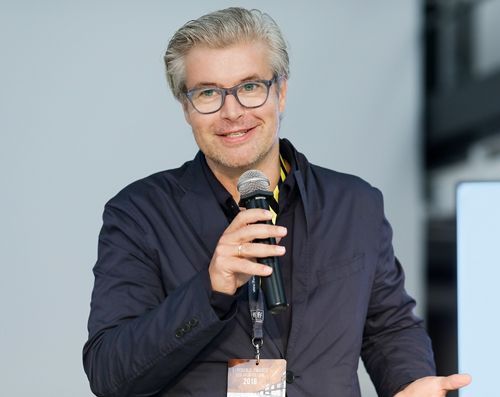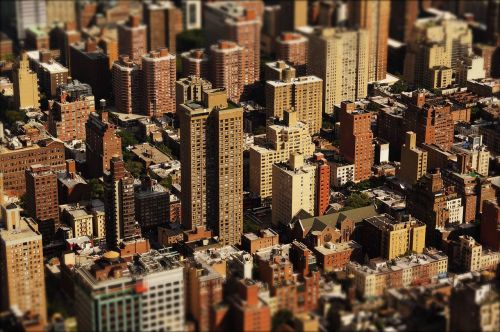Plants invade our thinking space
Architecture
Anna Pakulniewicz, ‘Eurobuild CEE’: I discovered during your presentation at the Architecture Festival organised by Eurobuild Conferences that you are no fan of plants in offices …
Thomas Feichtner, Thomas Feichtner Studio, designer: I have to say that I love nature; I love being outside. This year I spent a holiday in the Rocky Mountains without any connections – no mobile, no laptop, just a canoe on the lakes, so I am not against nature, but I only love it when it is outside. When I‘m indoors, I need to be focused. And what I like is a place where I can concentrate. There is an Arabic saying: “God made the desert so people have a place to think.” I think this is true. You need an open space, a blank space, somewhere where you can really do some thinking.
I like it when it is white and clear all around, but I really like my plant on my desk.
People need to have something like a horizon. To have space to clear the mind. That’s why it’s important not to have too many distractions. And to have the possibility to focus. So plants are nice, but when they overwhelm the space where I need to think, then they are not welcome. This is my personal opinion. I know that other people are completely different. Once I had an employee and she asked me if she could have a plant on her desk and so I said: “Well, of course, but don’t put a palm tree there.” She said, “Yeah, no problem” and she got herself a small cactus and placed it on her desk. She was happy, I was happy too. And then a TV station came to do some filming in my studio and all they could focus on was this cactus. Totally. So the camera only focused on the cactus and the story was about the cactus. Since then I’ve taken a different view of cactuses. Well. it’s important to have things like this, but on a scale that can be managed.
You don’t just design furniture...
I mainly design manufactured goods, all kinds of miscellanea. I really like such things. I think through their design, I think about how they work, what effect they have on our lives and how they influence my life. I am addicted to them.
But you design a lot of things, don’t you?
No. I try to reduce their number; I try not to have too many things in my life, in my private life. But with my family, with the kids, it is all a mess. I remember a time when I didn’t have kids and I was totally clear. But as a designer I design many different things out of different materials and I like to combine and play around with their design, putting things together.
We are living in such a time when everything has already been designed, everything has been invented, at least in terms of design. What might change? Do you expect design to revolutionise anything? Can design still be innovative?
I think design in general is a passion. It is a love of things, of discovery. And in this – let’s call it love – it’s often like a poem; it’s like a love song. And do you think that ever since The Beatles there are too many love songs in the world? We love new songs, new poems, new sounds. I think it’s the same with design. I am often asked to design a new chair, although we already have many chairs. And many love songs. But we still need more. So this is also a passion. Design is also a lot about reflecting on the future and what we expect from the future: our dreams and wishes for the future. These are things you always find in design. Think about design, for example, from the 50s and 60s when Apollo went to the Moon. This event changed everything in everybody’s lives. And raised expectations that we would go out and discover the universe. This was reflected in design. After the Second World War the future was reflected in design turning to hyperfunctionalism; in the 80s it turned to post modernism and a caricature of the architecture and design. There is no timeless design. Timeless design is a utopia.
What about materials? What will technology or electronics change?
A lot of new new materials are appearing, materials are always changing and materials are always fascinating. New materials being invented all the time. But there are such materials, such as glass – it is a very sustainable material. And porcelain – which is a very impressive material. Porcelain is so tough, it is tougher than steel or any carbon fibre. Nothing exists in the world that is tougher. Just think – a knife will be used to cut up food on a plate millions of times, but over a period of centuries you still won’t find a scratch on the plate. So for me porcelain is a very high-tech material. And there are so many materials on the periphery. Just think how in architecture people are turning to wood and how intelligent wood construction is now replacing steel and glass. And it is a very traditional material, but it is now being used in completely new ways. So nowadays you have construction that just ten years ago you wouldn’t have even believed was possible. So it is not about the materials but what you do with them – carbon, wood, porcelain. Generally in design, innovation is also very much driven by materials.
What about electronics and integrating the latest technology into furniture. Do you think that soon every piece of furniture is going to be plugged in?
No. But... of course there is the Internet of Things. The objects themselves will start to communicate and say where they are, what they are doing, who owns them and who is using them. Each item will send the information over the internet. This is a trend that is making such objects much more useful, much more intelligent and much more interactive. But not all of them. I don’t need a piece of furniture, such as a chair or a couch to be connected up. Maybe it’s different with office chairs – when you have a building with 6,000 employees you want to know where your chair is or which one is broken. So there’s a lot going on in this field. There will be a lot of connected things.
So more in the way of office design than for the home?
The IoT will be applied to all manufactured items – to nearly all of them. This can be most clearly seen in cars: you cannot buy a new car that is not connected. But we’re seeing it in goods that are highly complex, but for things that are not, such as glass, chairs, and lights, there is no need for any connectivity.
Lights? But they are very much connected these days– Lights are one of the fastest changing manufactured items in terms of their design and connectivity.
For lighting a gallery – yes, but I am talking about a reading light that you can turn on next to your bed...
But these can also be connected. You can turn it off and on or even change the colour and brightness with a mobile app.
Wow. Ok!
Do you think that the design is international?
If you had asked me this questions years ago, I would have answered simply – yes. We are in a completely global age. We are all connected; we almost use the same things – there is no diversity. But the older I get, the more diversity I see. I’m seeing more. This is not just typical for Austria, this is typical for France and typical for whatever country.
You designed the Studio for Bene office system that I have just seen at the Eurobuild Festival of Architecture. Do you think that such a table is for everyone? Would it be liked everywhere?
No, the piece of furniture I designed for Bene is aimed at a younger crowd. It is aimed at the creative industries for people like me, I would say, although I am a bit too old for it. It’s designed for a new way of working with much more freedom that is far more digital. When you look at classic office furniture, where everything can be adjusted, it looks machine-like. It’s designed to make you a more efficient worker. But if I were an employee of a company that gave me furniture to make me work at maximum efficiency, I wouldn’t be happy; I’d feel like a machine and I wouldn’t feel valued. I would feel that all they wanted from me was for me to work. I wouldn’t feel that I was an individual. I wouldn’t feel respected. So office furniture should make you feel that you are equal, that you are respected. It should be friendly and the same furniture should be used by the employee as by the CEO. They use the same paper and the same computers and CEOs no longer have five secretaries in front of their offices anymore – those days are gone. CEOs write their e-mails themselves, so why then should they use different furniture. I see the world in more democratic terms. ν
A man of consummate design
Thomas Feichtner is an internationally renowned designer. He was born in Brazil and grew up in Austria. He studied industrial design at the University of Art and Industrial Design in Linz. He has produced numerous designs for international brands, such as Adidas, Swarovski, Laufen, Bene, Head, Absolut, Augarten, Neue Wiener Werkstätten, Porzellanmanufaktur, J&L Lobmeyr, TON and Carl Mertens, and has collaborated with such manufacturers as Vitra, Thonet and FSB. Much of his work falls midway between manufactured and hand-crafted goods and he has produced designs both for one-offs and mass produced goods. He has exhibited his designs at the Triennale di Milano, the International Biennial of Design in Saint Etienne, the Austrian Cultural Forum London as well as the MAK – Austrian Museum of Applied Arts / Contemporary Art in Vienna. His works have received international design awards and been acquired by various design collections. His monograph, ‘Thomas Feichtner – Edge to Edge’, was published by the MAK – Austrian Museum of Applied Arts / Contemporary Art through Birkhäuser in 2010. From 2009 to 2014 he was a professor of product design at the Muthesius Academy of Fine Arts and Design in Kiel. In 2011 he received the Austrian State Award for Design. He lives and works in Vienna with his wife Simone.






















































